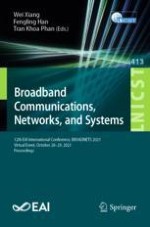2022 | Buch
Broadband Communications, Networks, and Systems
12th EAI International Conference, BROADNETS 2021, Virtual Event, October 28–29, 2021, Proceedings
herausgegeben von: Wei Xiang, Fengling Han, Tran Khoa Phan
Verlag: Springer International Publishing
Buchreihe : Lecture Notes of the Institute for Computer Sciences, Social Informatics and Telecommunications Engineering
